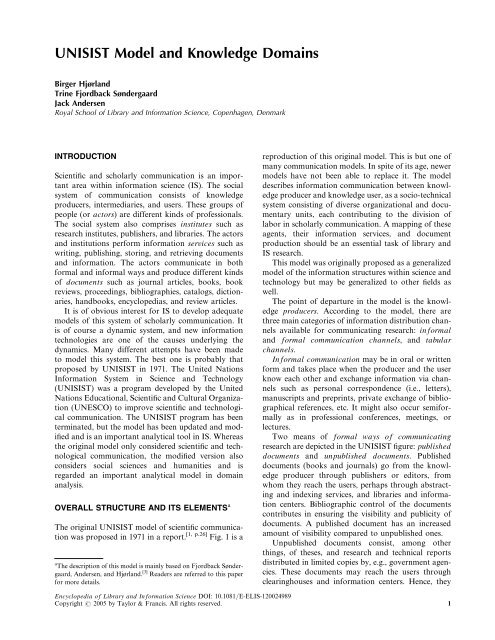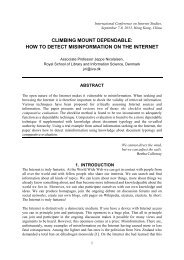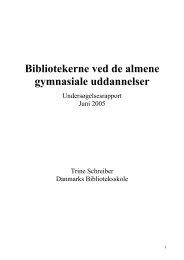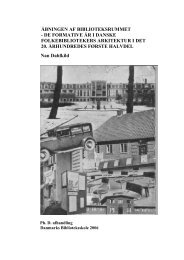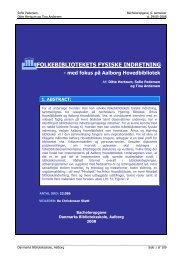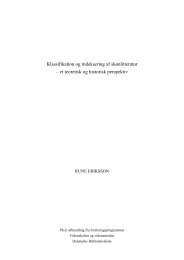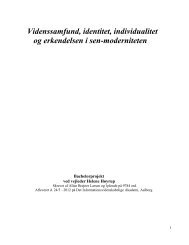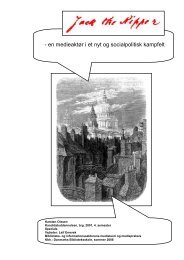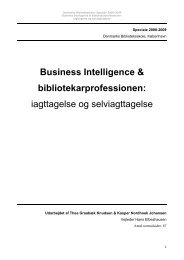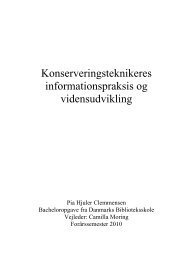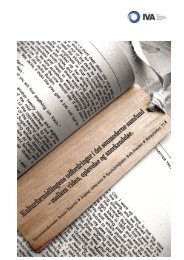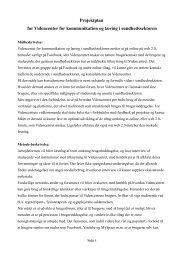UNISIST Model and Knowledge Domains
UNISIST Model and Knowledge Domains
UNISIST Model and Knowledge Domains
You also want an ePaper? Increase the reach of your titles
YUMPU automatically turns print PDFs into web optimized ePapers that Google loves.
<strong>UNISIST</strong> <strong>Model</strong> <strong>and</strong> <strong>Knowledge</strong> <strong>Domains</strong><br />
Birger Hjørl<strong>and</strong><br />
Trine Fjordback Søndergaard<br />
Jack Andersen<br />
Royal School of Library <strong>and</strong> Information Science, Copenhagen, Denmark<br />
INTRODUCTION<br />
Scientific <strong>and</strong> scholarly communication is an important<br />
area within information science (IS). The social<br />
system of communication consists of knowledge<br />
producers, intermediaries, <strong>and</strong> users. These groups of<br />
people (or actors) are different kinds of professionals.<br />
The social system also comprises institutes such as<br />
research institutes, publishers, <strong>and</strong> libraries. The actors<br />
<strong>and</strong> institutions perform information services such as<br />
writing, publishing, storing, <strong>and</strong> retrieving documents<br />
<strong>and</strong> information. The actors communicate in both<br />
formal <strong>and</strong> informal ways <strong>and</strong> produce different kinds<br />
of documents such as journal articles, books, book<br />
reviews, proceedings, bibliographies, catalogs, dictionaries,<br />
h<strong>and</strong>books, encyclopedias, <strong>and</strong> review articles.<br />
It is of obvious interest for IS to develop adequate<br />
models of this system of scholarly communication. It<br />
is of course a dynamic system, <strong>and</strong> new information<br />
technologies are one of the causes underlying the<br />
dynamics. Many different attempts have been made<br />
to model this system. The best one is probably that<br />
proposed by <strong>UNISIST</strong> in 1971. The United Nations<br />
Information System in Science <strong>and</strong> Technology<br />
(<strong>UNISIST</strong>) was a program developed by the United<br />
Nations Educational, Scientific <strong>and</strong> Cultural Organization<br />
(UNESCO) to improve scientific <strong>and</strong> technological<br />
communication. The <strong>UNISIST</strong> program has been<br />
terminated, but the model has been updated <strong>and</strong> modified<br />
<strong>and</strong> is an important analytical tool in IS. Whereas<br />
the original model only considered scientific <strong>and</strong> technological<br />
communication, the modified version also<br />
considers social sciences <strong>and</strong> humanities <strong>and</strong> is<br />
regarded an important analytical model in domain<br />
analysis.<br />
OVERALL STRUCTURE AND ITS ELEMENTS a<br />
The original <strong>UNISIST</strong> model of scientific communication<br />
was proposed in 1971 in a report. [1, p.26] Fig. 1 is a<br />
a The description of this model is mainly based on Fjordback Søndergaard,<br />
Andersen, <strong>and</strong> Hjørl<strong>and</strong>. [3] Readers are referred to this paper<br />
for more details.<br />
reproduction of this original model. This is but one of<br />
many communication models. In spite of its age, newer<br />
models have not been able to replace it. The model<br />
describes information communication between knowledge<br />
producer <strong>and</strong> knowledge user, as a socio-technical<br />
system consisting of diverse organizational <strong>and</strong> documentary<br />
units, each contributing to the division of<br />
labor in scholarly communication. A mapping of these<br />
agents, their information services, <strong>and</strong> document<br />
production should be an essential task of library <strong>and</strong><br />
IS research.<br />
This model was originally proposed as a generalized<br />
model of the information structures within science <strong>and</strong><br />
technology but may be generalized to other fields as<br />
well.<br />
The point of departure in the model is the knowledge<br />
producers. According to the model, there are<br />
three main categories of information distribution channels<br />
available for communicating research: informal<br />
<strong>and</strong> formal communication channels, <strong>and</strong> tabular<br />
channels.<br />
Informal communication may be in oral or written<br />
form <strong>and</strong> takes place when the producer <strong>and</strong> the user<br />
know each other <strong>and</strong> exchange information via channels<br />
such as personal correspondence (i.e., letters),<br />
manuscripts <strong>and</strong> preprints, private exchange of bibliographical<br />
references, etc. It might also occur semiformally<br />
as in professional conferences, meetings, or<br />
lectures.<br />
Two means of formal ways of communicating<br />
research are depicted in the <strong>UNISIST</strong> figure: published<br />
documents <strong>and</strong> unpublished documents. Published<br />
documents (books <strong>and</strong> journals) go from the knowledge<br />
producer through publishers or editors, from<br />
whom they reach the users, perhaps through abstracting<br />
<strong>and</strong> indexing services, <strong>and</strong> libraries <strong>and</strong> information<br />
centers. Bibliographic control of the documents<br />
contributes in ensuring the visibility <strong>and</strong> publicity of<br />
documents. A published document has an increased<br />
amount of visibility compared to unpublished ones.<br />
Unpublished documents consist, among other<br />
things, of theses, <strong>and</strong> research <strong>and</strong> technical reports<br />
distributed in limited copies by, e.g., government agencies.<br />
These documents may reach the users through<br />
clearinghouses <strong>and</strong> information centers. Hence, they<br />
Encyclopedia of Library <strong>and</strong> Information Science DOI: 10.1081/E-ELIS-120024989<br />
Copyright # 2005 by Taylor & Francis. All rights reserved. 1
2 <strong>UNISIST</strong> <strong>Model</strong> <strong>and</strong> <strong>Knowledge</strong> <strong>Domains</strong><br />
Fig. 1 The flow of scientific <strong>and</strong> technical information. (From Ref. [1] ; p. 26.)<br />
are not subject to the same selection, production, <strong>and</strong><br />
distribution procedures of publishers <strong>and</strong> editors that<br />
published documents go through. The notion of gray<br />
literature is somewhere in between published <strong>and</strong><br />
unpublished documents. A private letter is unpublished,<br />
while a report registered by a clearinghouse is<br />
semipublished or gray literature. Ph.D. dissertations,<br />
published on dem<strong>and</strong> at the University Microfilm<br />
International (UMI) <strong>and</strong> indexed in Dissertation<br />
Abstracts International, are another example of<br />
semipublications.<br />
The third category of communicating research is<br />
through tabular channels. This consists of numerical<br />
data. The original model chooses to regard this an<br />
independent channel, although it recognizes that<br />
much tabular information is distributed in normal
<strong>UNISIST</strong> <strong>Model</strong> <strong>and</strong> <strong>Knowledge</strong> <strong>Domains</strong> 3<br />
publications (<strong>and</strong> also in semipublications or in unpublished<br />
documents). b<br />
So far, the primary sources of scientific <strong>and</strong> technical<br />
information have been described in terms of their<br />
selection, production, <strong>and</strong> distribution functions.<br />
Primary literature is the point of departure in the production<br />
of scientific <strong>and</strong> scholarly knowledge <strong>and</strong> for<br />
the communicative division of labor of the literatures<br />
involved. The task of this literature is to produce<br />
<strong>and</strong> present original knowledge claims; this is why primary<br />
literature places emphasis on methodological<br />
descriptions.<br />
In the <strong>UNISIST</strong> model, we observe three levels of<br />
information source services between the knowledge<br />
producers <strong>and</strong> users: Besides the primary sources, there<br />
are also secondary <strong>and</strong> tertiary sources=services. c This<br />
is the basic taxonomy of information sources in the<br />
model (see the Appendix for the full model including<br />
the categories added in the revised version). The<br />
secondary information services register <strong>and</strong> describe<br />
primary documents for the purpose of retrieval <strong>and</strong><br />
documentation. Secondary literature, such as subject<br />
bibliographies; citation indexes; library catalogs; <strong>and</strong><br />
databases, analyses, describes, <strong>and</strong> registers primary<br />
literature d mainly in these bibliographical instruments.<br />
The central working processes of the secondary sources<br />
are analysis, storage, <strong>and</strong> dissemination. The model<br />
shows abstracting <strong>and</strong> indexing services, libraries,<br />
information centers, clearinghouses, <strong>and</strong> data centers,<br />
which are considered secondary information services,<br />
each with particular functions to perform. Tertiary<br />
literature is, for example, professional h<strong>and</strong>books<br />
<strong>and</strong> encyclopedias <strong>and</strong> literature reviews, which consolidate,<br />
collect, <strong>and</strong> synthesize the primary literature.<br />
Abstracting <strong>and</strong> Indexing Services<br />
The <strong>UNISIST</strong> model distinguishes between two kinds<br />
of abstracting <strong>and</strong> indexing services. The first one<br />
consists of printed secondary journals prepared <strong>and</strong><br />
distributed by scientific associations that operate on a<br />
b<br />
The <strong>UNISIST</strong> model privileged ‘‘tabular data’’ that presumably<br />
meant socio-economic numeric data series, tables of constants, observational<br />
data in numeric form, <strong>and</strong> the like; but it was an awkward<br />
phrase even then. That view (or at least wording) is obsolete in the<br />
sense that the key characteristic now is ‘‘digital’’ not ‘‘tabular’’<br />
<strong>and</strong> includes vast databases of images <strong>and</strong> other resources not<br />
usually considered ‘‘tabular data.’’<br />
c<br />
The terms primary (or secondary or tertiary) information sources<br />
may be used interchangeably with primary (or secondary or tertiary)<br />
information services: The actors or institutions that produce the<br />
sources represent the services. Also, the term literature(s) might be<br />
used interchangeably with information sources.<br />
d<br />
Although emphasis is on primary sources, secondary sources may<br />
also include tertiary sources.<br />
profit basis. An example of this kind is Chemical<br />
Abstracts or the Citation Indexes produced by the<br />
Institute for Scientific Information (ISI); that is the<br />
content of these does not represent collection of a<br />
physical location such as a library. The other service<br />
consists of catalogs <strong>and</strong> index files compiled by the<br />
staff of libraries or information centers as a mean of<br />
accessing their own collections. Also, guides <strong>and</strong> referral<br />
services belong to the second service produced by<br />
libraries <strong>and</strong> information centers. Referral services<br />
provide an indication of sources (persons, institutions,<br />
publications, etc.), from which scientific information<br />
may be obtained on a given subject <strong>and</strong> are mechanisms<br />
for switching users to such sources.<br />
Information Centers<br />
The concept of an information center is ambiguous,<br />
<strong>and</strong> the model’s relation to similar concepts such as<br />
libraries or documentation centers is not clarified.<br />
According to the model, the information center combines<br />
some of the functions of secondary journals<br />
<strong>and</strong> specialized libraries, to which are added specific<br />
duties such as the selective dissemination of information,<br />
or the preparation of state-of-art monographs,<br />
trend reports, reviews, etc. for the benefit of a specialized<br />
field or well-defined <strong>and</strong> more restricted user<br />
groups. "The role of such [information] centers is<br />
sometimes spoken of as that of ‘repackaging’ the information<br />
provided by abstracting <strong>and</strong> indexing services,<br />
according to the requirements of specific users; they<br />
operate then as ‘tertiary’ services, with a synthesis<br />
function added to those of indexing <strong>and</strong> classification:<br />
reorganization, quality control, compression, synthesis,<br />
evaluation etc.’’ [1, p. 30] Typical examples of tertiary<br />
documents are as previously mentioned literature<br />
reviews <strong>and</strong> syntheses.<br />
Because information centers perform both secondary<br />
<strong>and</strong> tertiary functions, they actually differ from<br />
libraries. It may be stated that whereas libraries are a<br />
kind of information center, the latter is not a kind of<br />
library. Libraries do not usually produce reviews,<br />
syntheses, or other kinds of tertiary documents.<br />
Moreover, information centers are normally not in<br />
the possession of a physical collection of documents<br />
<strong>and</strong> are not primarily concerned with giving access to<br />
these collections, as are libraries. When the <strong>UNISIST</strong><br />
(1971) model was proposed, information centers were<br />
often conceived of as centers that provided bibliographic<br />
references or information from documents<br />
‘‘information’’ but not documents. See also Ref. [2] ).<br />
It has often been seen as an ideal means to present pure<br />
information, whereas documents have been viewed as<br />
obsolete medium of information. Centers that delivered<br />
bibliographical records (usually for a fee) from
4 <strong>UNISIST</strong> <strong>Model</strong> <strong>and</strong> <strong>Knowledge</strong> <strong>Domains</strong><br />
electronic databases grew rapidly developed from<br />
about 1965 until 1990 <strong>and</strong> were usually part of<br />
libraries, particularly in the scientific <strong>and</strong> technological<br />
fields. Such departments were important, for example,<br />
those in the Danish Technological Library <strong>and</strong> the<br />
Main Medical Library in Copenhagen (<strong>and</strong> correspondingly,<br />
for example, centers in Stockholm as well<br />
as in other cities in the world). They were usually<br />
referred to as Documentation Departments. With the<br />
introduction of CD-ROM databases <strong>and</strong> ‘‘end-user’’<br />
oriented search interfaces around 1990, these departments<br />
have by <strong>and</strong> large disappeared or have been<br />
downsized.<br />
The <strong>UNISIST</strong> model operates only for a basic<br />
concept of information center. In the following, we<br />
use information center as an umbrella term for<br />
libraries, documentation centers, <strong>and</strong> other similar<br />
activities concerning the collection, dissemination,<br />
storage, retrieval, <strong>and</strong> organization of documents<br />
(or knowledge).<br />
Clearinghouses<br />
Clearinghouses are defined by the <strong>UNISIST</strong> as<br />
‘‘ ...institutions entrusted with the procurement <strong>and</strong><br />
dissemination of special categories of documents, such<br />
as technical reports, dissertation theses, thesauri,<br />
etc.’’ [1, p. 147] According to the <strong>UNISIST</strong> report, the<br />
modes of analysis, storage, <strong>and</strong> dissemination here<br />
are the same as those of libraries or information centers.<br />
However, what differentiates clearinghouses from<br />
libraries or information centers is the attention exclusively<br />
paid to unpublished documents. e<br />
Data Centers<br />
The <strong>UNISIST</strong> model conceives of data centers as being<br />
different from the abovementioned secondary services<br />
because ‘‘ ...they [data centers] deal exclusively with<br />
the raw material of science, parallel or even prior to<br />
publication ...,’’ [1, p. 30] <strong>and</strong> because functions (catalog<br />
ing, abstracting, indexing, synthesizing, etc.) of the<br />
other kinds of secondary services ‘‘ ...are normally<br />
defined with respect to written documents.’’<br />
[1, p. 31]<br />
That is, the <strong>UNISIST</strong> model conceives of data centers<br />
as being concerned with ‘‘raw’’ data <strong>and</strong> nonwritten<br />
documents such as quantified surveys.<br />
Fjordback Søndergaard, Andersen, <strong>and</strong> Hjørl<strong>and</strong> [3]<br />
in their revision decided, however, to consider data<br />
e When broadening the <strong>UNISIST</strong> model to other fields such as the<br />
humanities, there is an obvious need for comparing the functions<br />
of clearinghouses <strong>and</strong> archives.<br />
centers as part of the other units in the model as data<br />
that are published through formal communication<br />
channels such as publishers. This implies that we will<br />
exclude data centers as an independent form of information<br />
service <strong>and</strong> information source. This decision<br />
to not regard data centers as a specific communication<br />
channel is also motivated by the facts that other kinds<br />
of messages such as computer programs, pictures, <strong>and</strong><br />
sounds are not represented by separate channels.<br />
Special Bibliographies, Translations, etc.<br />
As seen in the <strong>UNISIST</strong> model, organizations for<br />
information <strong>and</strong> documentation may produce special<br />
bibliographies, whether current or those of earlier<br />
times. Translation services may be commercial, or as<br />
in government centers they may be special translation<br />
journals (e.g., ‘‘cover to cover’’ translation of Russian<br />
scientific journals to English). They may also be bibliographies<br />
covering translations (such as Index translationum.<br />
Répertoire International des Traductions=<br />
International Bibliography of Translations—published<br />
by UNESCO).<br />
Review, Syntheses, etc.<br />
Here, reviews should not be confused with book<br />
reviews. Reviews are syntheses of the primary literature,<br />
e.g., in the form of h<strong>and</strong>books, review articles,<br />
scientific <strong>and</strong> professional encyclopedias, <strong>and</strong> the like.<br />
(This is unlike works like general encyclopedias that<br />
are not primarily written for subject specialists nor<br />
are a part of the scientific literature described in the<br />
original <strong>UNISIST</strong> model. They may be seen as a<br />
special kind of literature, popular literature.) One<br />
important kind of tertiary literature is the series titled<br />
‘‘Annual Reviews of X,’’ e.g., the Annual Review of<br />
Information Science <strong>and</strong> Technology. Many of such<br />
annual reviews have high impact factors in their<br />
respective fields.<br />
Users<br />
The final unit in the model is the users. Users of scientific<br />
<strong>and</strong> technical information are in most cases also<br />
identical to the producers, or they may also be practitioners<br />
such as physicians. The different roles of users<br />
determine their information needs <strong>and</strong> make specific<br />
constraints on their use of information. Researchers<br />
are generally intensive users of informal <strong>and</strong> primary<br />
sources within a narrow specialty, whereas practitioners<br />
are generally users of a broader range of<br />
sources <strong>and</strong> may rely more on tertiary sources.
<strong>UNISIST</strong> <strong>Model</strong> <strong>and</strong> <strong>Knowledge</strong> <strong>Domains</strong> 5<br />
THEORETICAL REVISION AND<br />
TECHNOLOGICAL UPDATION<br />
OF THE MODEL<br />
There are two main reasons why Fjordback Søndergaard,<br />
Andersen, <strong>and</strong> Hjørl<strong>and</strong> [3] found it necessary<br />
to update <strong>and</strong> revise the original model:<br />
1. The need to consider differences between different<br />
disciplines <strong>and</strong> domains <strong>and</strong> to generalize<br />
the model <strong>and</strong> its document typology (or the system<br />
of kinds of document) from science <strong>and</strong><br />
technology to other domains.<br />
2. The growing impact of the Internet on scientific<br />
<strong>and</strong> scholarly communication.<br />
These considerations have been incorporated in the<br />
modified model shown in Figs. 2 <strong>and</strong> 3 <strong>and</strong> are introduced<br />
in the rest of this article. In Fig. 2, the Internet<br />
services have been displayed as a separate entity,<br />
whereas print <strong>and</strong> electronic media are integrated as<br />
seen in Fig. 3<br />
Concern 1: Considering Different<br />
<strong>Domains</strong><br />
Fig. 2 has a punctured ellipse symbolizing a scientific<br />
discipline or a knowledge domain. The ellipse can symbolize,<br />
for example, the biological, the medical, or the<br />
legal discourse community. Such domains are typically<br />
overlapping, open structures, as is the case in the biomedical<br />
domain, where the borders of biology <strong>and</strong><br />
medicine are difficult to identify. The ellipse is (more<br />
or less) punctured in order to illustrate this open nature<br />
of domains. The knowledge producers, the users,<br />
<strong>and</strong> the intermediaries are thus all considered members<br />
of a domain (or discourse community). Different services<br />
<strong>and</strong> institutions may, however, be shared between<br />
different domains. This is especially the case with interdisciplinary<br />
institutions <strong>and</strong> tools such as, for example,<br />
the Science Citation Index <strong>and</strong> national libraries. A<br />
given domain may, in other words, exercise more or<br />
less control with regard to its own informational infrastructure,<br />
<strong>and</strong> the institutions (e.g., publishers <strong>and</strong><br />
libraries) may or may not have adequate subject<br />
knowledge <strong>and</strong> engagements to fulfill the functions in<br />
optimal ways.<br />
A new feature in the revised model is the arrows<br />
symbolizing the import <strong>and</strong> export of knowledge into<br />
the domain <strong>and</strong> out of the domain. The revised model<br />
recognizes that the information producers also use<br />
information sources. They may get information from<br />
sources in their own domain, other domains, direct<br />
observation of natural information sources, or from<br />
the general public. Some domains get most of their<br />
knowledge from their own domain. This is the case<br />
with mathematics, economics, <strong>and</strong> psychology. Other<br />
domains such as agriculture get most of their input<br />
from other domains, e.g., chemistry. Different epistemologies<br />
in a given domain will emphasize different<br />
knowledge sources. Social constructivism is, for example,<br />
an epistemological position that claims that<br />
researchers’ direct observations of nature are mediated<br />
by information sources of a social nature, which is a<br />
contrast to an empiricist or positivist epistemology.<br />
Export may be directed toward other disciplines or<br />
the general public. In engineering, physical products<br />
are, e.g., speakers or cars, the normal products<br />
exported from the knowledge production in the<br />
domain. In this domain, researchers seem to prefer<br />
making commercial products rather than writing<br />
research papers. Such products may however, be documented<br />
in patents. In science, publication of articles in<br />
journals is the norm, whereas journals compete with<br />
books in humanities. The articles may be printed in<br />
journals of the researcher’s own discipline, in those<br />
related to other disciplines, or in general scientific<br />
journals. The category of popular literature in the<br />
document typology is especially designed to serve<br />
dissemination of knowledge to the public domain or<br />
to beginners (See Appendix, ‘‘Popular literature’’).<br />
<strong>Domains</strong> vary much in their exports of knowledge to<br />
the general public. Humanities typically have a much<br />
closer relationship to the mass media <strong>and</strong> the general<br />
public compared to scientific publications.<br />
The domain itself reflects the division of labor in<br />
society (e.g., the division between people working with<br />
health problems in the health domain <strong>and</strong> those working<br />
with legal problems in the legal domain). Inside<br />
each domain, there is a more or less developed internal<br />
division of labor, e.g., between theoretical <strong>and</strong> empirical<br />
researchers, assistants, administrators, computer<br />
specialists, librarians=information specialists, translators,<br />
publishers, practitioners, etc. Often, the practitioners<br />
are the end users of the knowledge produced<br />
by the researchers. This can be, for example, the doctor<br />
curing a patient by applying new research results. The<br />
most important thing to realize is that each domain has<br />
a unique structure that should be described empirically<br />
<strong>and</strong> explained theoretically. A central point in the<br />
domain analytic approach to IS is the claim that tools,<br />
languages for special purposes (LSP), concepts, meaning,<br />
information structures, information needs, <strong>and</strong><br />
relevance criteria are shaped in discourse communities.<br />
Different scientific, scholarly, or professional domains<br />
have unique structures of documents, which reflect an<br />
adaptation to the special needs in the domain. Some<br />
examples of unique kinds of documents are:<br />
Almanacs in astronomy<br />
Patents in engineering
6 <strong>UNISIST</strong> <strong>Model</strong> <strong>and</strong> <strong>Knowledge</strong> <strong>Domains</strong><br />
Fig. 2 The revised <strong>UNISIST</strong> model modified for the domain analytic approach. # Emerald. (From Ref. [3] ; p. 303.)
<strong>UNISIST</strong> <strong>Model</strong> <strong>and</strong> <strong>Knowledge</strong> <strong>Domains</strong> 7<br />
Fig. 3 The revised <strong>UNISIST</strong> model integrating printed <strong>and</strong> Internet resources <strong>and</strong> modified according to the domain analytic<br />
approach. (From Ref. [4] ; p. 96.) (View this art in color at www.dekker.com.)<br />
Maps <strong>and</strong> atlases in geography<br />
Pedigrees <strong>and</strong> genealogical trees in genealogy<br />
Codes, bodies of law in law<br />
Sheets of music in music<br />
Tests in psychology<br />
Such specific elements are, however, not contained<br />
in general versions of the <strong>UNISIST</strong> model; one must<br />
but await the development of domain-specific models.<br />
Some scholarly fields have special information services<br />
providing prepared materials for research.
8 <strong>UNISIST</strong> <strong>Model</strong> <strong>and</strong> <strong>Knowledge</strong> <strong>Domains</strong><br />
While all documents may serve research, some do this<br />
in a special way in the form of providing access to reliable<br />
source documents. This is especially the case in<br />
historical research. Archives <strong>and</strong> museums are important<br />
institutions missing in the original <strong>UNISIST</strong><br />
model. They are very important in humanities <strong>and</strong><br />
may also be important in some scientific fields. The<br />
study of archives <strong>and</strong> museums may thus be seen as<br />
parts of IS. Often, archives <strong>and</strong> other institutions<br />
reproduce <strong>and</strong> publish important historical documents<br />
in order to make such unique documents much more<br />
visible <strong>and</strong> available to scholars. This is a unique kind<br />
of work <strong>and</strong> should not be overlooked. In the Appendix,<br />
we have added ‘‘Source Literature’’ as a new category<br />
beyond the primary, secondary, tertiary forms<br />
known from the original <strong>UNISIST</strong> model.<br />
Among the other changes in the revised model that<br />
can be mentioned are integration of libraries <strong>and</strong> information<br />
centers into one box <strong>and</strong> addition of book<br />
reviews. The fundamental structure of the original<br />
model remains, i.e., the differentiation between primary,<br />
secondary, <strong>and</strong> tertiary sources <strong>and</strong> services.<br />
As mentioned earlier, we have added source literature<br />
as a new category. The figure (<strong>and</strong> the Appendix)<br />
shows the addition of thesauri <strong>and</strong> dictionaries also<br />
as a new category. Finally, the classification ‘‘Incidental<br />
Information’’ in the Appendix is a primary one for<br />
other sources <strong>and</strong> services that do not fit into other<br />
categories but nevertheless are important in scholarly<br />
communication.<br />
National <strong>and</strong> regional substructures<br />
The original <strong>UNISIST</strong> model was conceived of as one<br />
universal international structure. In reality, however,<br />
there exist more or less independent <strong>and</strong> elaborated<br />
national or regional information substructures in most<br />
domains. If we take psychology as an example, there<br />
exist regional journals of psychology, as well as<br />
internationally published journals from American<br />
<strong>and</strong> Germany. The German Information System for<br />
Psychology is the most elaborate information system<br />
outside the U.S.A. in this domain. In this national system,<br />
we find a complete system of primary, secondary,<br />
<strong>and</strong> tertiary information services. The primary information<br />
system in German psychology consists of journals<br />
covering all major subfields such as experimental<br />
psychology, social psychology, clinical psychology,<br />
developmental psychology, etc. proceedings of conferences,<br />
books in all fields of psychology, <strong>and</strong> scholarly<br />
treatises. It has under its fold about 150 publishers<br />
<strong>and</strong> producers of tests. The secondary information<br />
system contains a comprehensive bibliographical database,<br />
PSYNDEX, with abstracts <strong>and</strong> indexing of<br />
the German literature in both English <strong>and</strong> German.<br />
Also, many kinds of dictionaries are being developed.<br />
The tertiary information system contains comprehensive<br />
h<strong>and</strong>books, encyclopedias, review journals, etc.<br />
The German system also contains specialized information<br />
systems developed to communicate psychological<br />
knowledge to students <strong>and</strong> to the general public (e.g.,<br />
textbooks <strong>and</strong> the magazine Psychologie Heute).<br />
Today, there is increasing political pressure toward<br />
internationalization. Such a pressure may motivate<br />
German psychologists (among others) to publish in<br />
American (or international) journals, <strong>and</strong> it may leave<br />
the impression that other national or regional substructures<br />
are obsolete <strong>and</strong> inappropriate in scientific<br />
communication. This issue has been intensively<br />
debated <strong>and</strong> we shall not go deeper into this issue here. f<br />
As long as regional systems exist, they should be taken<br />
seriously by information scientists <strong>and</strong> should be<br />
reflected in our modeling <strong>and</strong> bibliometric studies of<br />
domains <strong>and</strong> the coverage of databases. The concept<br />
of regional subsystems is related to philosophical <strong>and</strong><br />
sociological question about the nature of different<br />
traditions in science <strong>and</strong> scholarship.<br />
Paradigmatic differences<br />
In addition to disciplinary <strong>and</strong> regional=geographical<br />
differences, each domain will have—more or less<br />
noticeably—variations in its information system that<br />
are due to paradigmatic differences between the actors<br />
in the field. In psychology, for example, there is almost<br />
a complete information system for the psychoanalytic<br />
approach to psychology, consisting of primary journals,<br />
specific organizations, indexes <strong>and</strong> abstracts<br />
journals, encyclopedias <strong>and</strong> terminological works, etc.<br />
This system is not just relatively independent of the<br />
‘‘general’’ psychological system; it also has attributes<br />
that reflect the special nature of that field. Thus, psychoanalytic<br />
literature is more related to the humanities<br />
compared to the literature of behaviorism, cognitivism,<br />
<strong>and</strong> neuroscience. This is reflected in the tendency to<br />
organize the literature on authorship basis (Sigmund<br />
Freud’s works, C.G. Jung’s works, Melanie Klein’s<br />
works, etc). It is also reflected by the relative dominance<br />
of books compared to articles <strong>and</strong> by the rhetorical<br />
structure of the texts.<br />
Although such paradigmatic tendencies may be<br />
weak, it is our opinion that they always tend to exist<br />
to some extent. One could say that in a given (sub)<br />
f Michael Brittain [5] wrote ‘‘The claims of the social sciences to be of<br />
universal interest, value, <strong>and</strong> use are challenged. Citation data show<br />
that there is not a free flow of information across language <strong>and</strong><br />
national boundaries,’’ <strong>and</strong> he considers the implication for information<br />
services. This is still an important issue.
<strong>UNISIST</strong> <strong>Model</strong> <strong>and</strong> <strong>Knowledge</strong> <strong>Domains</strong> 9<br />
culture or domain, there will almost always exist<br />
different ‘‘paradigms’’ for how practices should be<br />
changed <strong>and</strong> how the discipline should be defined<br />
<strong>and</strong> further developed. Any change in practices implies<br />
a need to change the documents, the symbolic systems,<br />
<strong>and</strong> the concepts that support the existing practice. The<br />
given concepts <strong>and</strong> documents will always serve certain<br />
policies <strong>and</strong> practices better than other concepts <strong>and</strong><br />
documents. This is the case whether or not people<br />
are aware of this relationship. <strong>Domains</strong> are dynamic,<br />
<strong>and</strong> an important factor is the theoretical <strong>and</strong> epistemological<br />
development. When paradigms change, the<br />
whole model of the domain (as reflected in the UNI-<br />
SIST model) has to change too.<br />
Different concepts, documents, ways of cooperation,<br />
etc. are simply better suited for certain<br />
‘‘paradigms’’ than for other paradigms. This is why<br />
there is always a more or less latent tendency to<br />
develop separate information systems for separate<br />
views in any field. Only some disciplines (e.g., psychology<br />
<strong>and</strong> economics) have, however, specific journals<br />
specially devoted to different views. The epistemological<br />
issues may, however, turn out to be the most important<br />
dynamics underlying any information system.<br />
Concern 2: Internet-Based Communication<br />
As mentioned previously, Internet services have been<br />
displayed as a separate entity at the right in Fig. 2.<br />
The dynamics in scientific <strong>and</strong> scholarly communication<br />
caused by the technological changes from print<br />
to electronic media are of course very important. As<br />
stated by Smith, [6] the flow of computer mediated<br />
communication may cause a modification of the traditional<br />
categorization of documentary units. Some of<br />
the units may broaden or even modify their categorization<br />
in document type (primary, secondary, <strong>and</strong><br />
tertiary literature). Also, concepts such as documents<br />
<strong>and</strong> publications may have to be redefined. It is, however,<br />
with some modifications still possible to classify<br />
information sources according to the <strong>UNISIST</strong> model.<br />
How the growing impact of Internet based communication<br />
channels has changed the flow of scientific communication<br />
since the creation of the <strong>UNISIST</strong> model<br />
has been subject to research. Among others, Kling<br />
et al., [7–8] Hurd, [9–10] Meadows [11] <strong>and</strong> Russel [12] have<br />
proposed or discussed models for communication in the<br />
digital age. However, none of the suggested new models<br />
can replace the <strong>UNISIST</strong> model. Most descriptions of<br />
the documentary <strong>and</strong> organizational units on the Internet<br />
emerge from a classification of hardware or software technicalities,<br />
rather than that by functional communication<br />
parameters as used in the <strong>UNISIST</strong> model.<br />
As early as 1978, Lancaster suggested that ‘‘the<br />
distinction between formal <strong>and</strong> informal communi-<br />
cation will be much less clear in an all-electronic<br />
environment.’’ [13, p. 113–114] Though this is true for<br />
many of the new hybrid forms, most people would<br />
agree that a distinction between formal <strong>and</strong> informal<br />
is possible in everyday Internet based communication.<br />
Informal communication<br />
Consistent with contemporary use of the informal<br />
communication channels, the most significant informal<br />
documentary units on the Internet are:<br />
1. Email<br />
2. List servers, which are discussion groups or<br />
interest groups that distribute messages via<br />
mailing lists. Electronic conferences or newsletters<br />
are usually listserv mediated.<br />
3. Usenet News, which is a collective term for<br />
thous<strong>and</strong>s of newsgroups or discussion groups.<br />
Usenet News is managed centrally without the<br />
use of email in contrary to List servers. The<br />
messages or articles are most often cumulated<br />
<strong>and</strong> archived at least for a while. In most cases,<br />
this group includes bulletin boards, which are<br />
now rarely used on their own but rather as a<br />
feature among others in newsgroups. Thus,<br />
Lancaster [13, p.130] defined bulletin boards as a<br />
‘‘public space to permit messages to be entered<br />
<strong>and</strong> made accessible without restriction to all<br />
users of the system.’’<br />
4. Electronic meeting or webcam conferencing.<br />
Each of these informal communication channels on<br />
the Internet may be located by the user through either<br />
(1) various search engines, including meta search tools<br />
such as Metacrawler that allows one to access several<br />
search engines from one place, or (2) diverse types of<br />
virtual libraries. However, informal communication<br />
channels often become known to the users in the<br />
course of serendipity, general browsing, or interpersonal<br />
contacts.<br />
Generally speaking, the Internet mediates a less<br />
selective number of informal communication channels<br />
than the preceding nonelectronic ones. Information once<br />
available only through the professional grapevine is now<br />
found on personal or institutional web pages, [14, p. 274] this<br />
is why the Internet is believed to have a positive effect on<br />
the development of invisible colleges in the otherwise<br />
stratified scientific community. Harnad [15] has argued<br />
that when (informal) manuscripts <strong>and</strong> feedback are<br />
exchanged through the network, scholarship can progress<br />
at a speed more similar to that of natural thought<br />
<strong>and</strong> speech. Because of the ease of using the informal<br />
Internet based communication channels, the path from<br />
the producer to the user <strong>and</strong> vice versa is more freely<br />
<strong>and</strong> quickly accessed <strong>and</strong> less troublesome.
10 <strong>UNISIST</strong> <strong>Model</strong> <strong>and</strong> <strong>Knowledge</strong> <strong>Domains</strong><br />
Formal communication<br />
The increasing number of computer literate scholars<br />
through the 1990s, among other things, brought about<br />
the transition of the Internet from a predominantly<br />
informal communication channel to a significant<br />
formal communication channel.<br />
The most significant formal documentary units on<br />
the Internet are:<br />
1. E-journals <strong>and</strong> online journals: The true concept<br />
of the ‘‘electronic journal’’ or simply<br />
e-journal, as opposed to the ‘‘online journal,’’<br />
requires that the material be produced <strong>and</strong><br />
stored only in electronic form. [16] Online journals<br />
on the other h<strong>and</strong> are electronic spin-offs<br />
from paper journals.<br />
2. Preprints: Though some redaction has often<br />
occurred, preprints are documents distributed<br />
before the actual publication <strong>and</strong> perhaps<br />
before the peer-reviewing process is completed.<br />
Preprints are often considered a part of gray<br />
literature, but in recent years the emergence of<br />
preprint databases on the Internet has offered<br />
the means to gain access to this document type.<br />
However, not all disciplines have preprint databases;<br />
therefore depending on the knowledge<br />
domain is considered, preprints may or may<br />
not be considered gray. g<br />
3. Gray or unpublished literature such as theses,<br />
reports, etc. mostly found on scientific <strong>and</strong><br />
research organizational servers.<br />
Real, operational e-journals are essentially a<br />
phenomenon of the late 1990s. The first peer-reviewed<br />
electronic, full-text e-journal including graphics was<br />
Online Journal of Clinical Trials, which began publication<br />
only in 1992. [17] Research completed in 1996<br />
showed that some e-journals actually have a high<br />
impact factor. However, as Harter points out, few articles<br />
are published. ‘‘Indeed, e-journals cannot have a<br />
major impact on the advancement of knowledge until<br />
they publish many more articles annually than they<br />
do [in 1996], while maintaining the apparent high<br />
quality of their articles.’’<br />
[18, p.155]<br />
Weller [19] indicates that the peer-review process of<br />
e-journals is generally similar to the traditional process<br />
found in paper-based journals. However, new models<br />
of editorial peer review have been suggested, <strong>and</strong> some<br />
are being experimented with, which either alter or<br />
g The widely adopted practice of authors making copies of their<br />
papers available on their personal=institutional web sites should also<br />
be mentioned. In some domains, notably computer science, this has<br />
become the norm. It may be seen as a modern form of offprint.<br />
eliminate the traditional model of peer review. It is<br />
most important that any new model maintains the<br />
integrity of science <strong>and</strong> scholarly communication <strong>and</strong><br />
yet implements the new emerging electronic environment<br />
<strong>and</strong> the need for decreasing turn-around time.<br />
As an example, Weller mentions that in the electronic<br />
environment, there is a need to re-examine the anonymity<br />
of reviewers.<br />
Regarding the development of preprint databases,<br />
the Internet as a new media has played a vital role.<br />
Due to the scholar community’s discontent with publishing<br />
delays <strong>and</strong> distribution problems with paper<br />
journals, Paul Ginsparg created Los Alamos ePrint<br />
archive in 1991. Arthur Smith who sees journals merely<br />
as an overlay on preprint databases describes the<br />
powerful position of ePrint archives. ‘‘The tension concerning<br />
responsibility for public distribution <strong>and</strong> communication<br />
of new work has been resolved in favor of<br />
the electronic preprint databases. Traditional journals<br />
still have some role in communication, providing archival<br />
material <strong>and</strong> interlinking, but they no longer form<br />
the primary communication medium at either the formal<br />
or the public levels.’’ [6] As can be seen, the Internet<br />
has changed the perception <strong>and</strong> use of this document<br />
type at least in some science domains where rapid<br />
dissemination is required. However, further research<br />
is needed to identify <strong>and</strong> explain differences between<br />
domains on this matter.<br />
If the development continues in line with Arthur<br />
Smith’s ideas for the future, it could be argued that<br />
journals (electronic or paper-based) should be positioned<br />
as a secondary source instead of its present location<br />
among the primary sources. Smith [6] argues that<br />
the main purpose of the typical journal will be storage,<br />
<strong>and</strong> as a sign of formal confirmation the preprints will<br />
adopt the traditional journals’ communicative role.<br />
Whether or not this will come about depends on various<br />
conditions. The traditional position of journals<br />
is therefore maintained in the domain general model<br />
of Internet based scientific <strong>and</strong> technical information.<br />
Gray literature<br />
The Fourth International Conference on Grey Literature<br />
defined gray literature as ‘‘That which is produced<br />
on all levels of government, academics, business <strong>and</strong><br />
industry in print <strong>and</strong> electronic formats, but which is<br />
not controlled by commercial publishers.’’ [20] Gray<br />
literature on the Internet is, if possible to locate, very<br />
easily accessed compared with non-Internet based<br />
alternatives. The Internet has created an opportunity<br />
to make gray literature publicly available without the<br />
expenses of traditional publication.<br />
Several organizations, associations, <strong>and</strong> information<br />
systems such as the European Association for<br />
Grey Literature in Europe (EAGLE), Information
<strong>UNISIST</strong> <strong>Model</strong> <strong>and</strong> <strong>Knowledge</strong> <strong>Domains</strong> 11<br />
for Grey Literature in Europe (SIGLE), <strong>and</strong> the<br />
British Library Document Supply Centre (DSC) are<br />
making special efforts to raise awareness of <strong>and</strong> provide<br />
access to gray literature such as reports, theses,<br />
translations, noncommercial conferences, <strong>and</strong> official<br />
(government) material. Several bibliographies devoted<br />
to gray literature can be found on the Internet. The<br />
problems concerning gray literature are therefore being<br />
addressed on international level but may still dem<strong>and</strong><br />
the searcher to be rather persistent.<br />
Formal communication channels<br />
The formal documentary units (in particular journal<br />
articles) may be directly accessed if their address is<br />
known. Otherwise, the units on the Internet may reach<br />
the user through, for example:<br />
1. Preprint databases. h<br />
2. Bibliographic or full text databases. i<br />
3. Scientific <strong>and</strong> research organizations servers.<br />
4. Publisher web sites.<br />
5. Virtual libraries.<br />
6. Search engines <strong>and</strong> meta search tools.<br />
As with the role played by preprints, Smith [6] also<br />
anticipates changes in the function of preprint databases.<br />
Preprint databases are expected to become<br />
responsible for public distribution <strong>and</strong> communication<br />
of new works. This means that the user needs to have<br />
great domain specific knowledge or expertise since the<br />
content of these databases is not necessarily finalized<br />
by the peer-review process. For this reason, Smith<br />
presumes review papers to take on a more prominent<br />
role in providing guidance to the literature for those<br />
not familiar enough with the domain to deal with the<br />
nonreviewed preprint literature.<br />
The majority of bibliographic or full-text databases<br />
are available via the Internet (given a password), but<br />
many databases have yet to make value addition to<br />
their services further to this media. The terms electronic<br />
libraries (e-libraries), digital libraries, <strong>and</strong> virtual<br />
libraries are often used rather inconsistently <strong>and</strong><br />
h In the literature, these databases are not referred to as clearinghouses<br />
as found in the original <strong>UNISIST</strong> model. On the Internet,<br />
the term Clearinghouse seems to denote some kind of annotated<br />
directory or resource guide (See for example the Argus Clearinghouse<br />
at http:==www.clearinghouse.net=mission.html for further<br />
information). Preprint databases primarily flourish within the science<br />
domains such as Los Alamos ePrint, LANL preprint database, <strong>and</strong><br />
SPIRES.<br />
i Representing both commercial (First Search, DIALOG, STN, Lexis-<br />
Nexis) <strong>and</strong> noncommercial databases available on the Internet<br />
(OPACs also termed electronic libraries or e-libraries).<br />
several different definitions are seen in the literature<br />
<strong>and</strong> on the Internet.<br />
The preservation of paper based scientific communication<br />
is a part of the secondary organizational units in<br />
the original <strong>UNISIST</strong> model (e.g., libraries’ copyright<br />
deposits). Several archival initiatives are seen on the<br />
Internet. The Internet archive (http:==www.archive.<br />
org) is as an example of the preservation of former<br />
versions of web sites. Some countries (e.g., Denmark<br />
since 1998) have copyright deposits for some web<br />
documents, but coverage is selective <strong>and</strong> probably<br />
unsatisfactory. Also more subject specific archives<br />
exist.<br />
Publishers’ web sites are increasingly providing<br />
access to publications in addition to more traditional<br />
information such as subscription prizes, contributor<br />
instructions, <strong>and</strong> review policies. The specific searching<br />
<strong>and</strong> browsing facilities on these sites vary. The users’<br />
opportunities to view, print, or request documents<br />
differ as do their requirement for payment. The publishers’<br />
traditional role connected to selection, production,<br />
<strong>and</strong> distribution of the primary sources is<br />
increasingly supplemented with new roles concerned<br />
with storage <strong>and</strong> dissemination. Some publishers are<br />
beginning to utilize cross-referencing or reference linking<br />
as a browsing option. CrossRef is a collaborative<br />
reference linking service that functions as a sort of digital<br />
switchboard. It holds no full text content, but rather<br />
effects linkages through Digital Object Identifiers<br />
(DOI) that are tagged to article metadata supplied by<br />
the participating publishers. The result is a linking<br />
system through which a researcher can click on a<br />
reference in a journal <strong>and</strong> access the cited article.<br />
These facilities, however, are only available to the<br />
users who subscribe to the various publications. A<br />
researcher clicking on a CrossRef link will be automatically<br />
connected to a page on the publisher’s web site<br />
showing a full bibliographical citation of the article,<br />
<strong>and</strong>, in most cases, the abstract as well. Subscribers<br />
are generally authenticated for full text access, <strong>and</strong><br />
nonsubscribed users presented with other options for<br />
access (such as subscription, document delivery, or<br />
pay-per-view). Researchers in library environments<br />
may find that CrossRef links redirect to local holdings.<br />
This development suggests that the publishers are<br />
taking up the traditional secondary sources such as<br />
indexing <strong>and</strong> abstracting services, libraries, <strong>and</strong> information<br />
centers. If cross-referencing between the diverse<br />
publishers becomes st<strong>and</strong>ard, a new <strong>and</strong> potentially<br />
powerful information-searching tool may rise.<br />
Aids such as domain specific dictionaries, glossaries,<br />
taxonomies, <strong>and</strong> thesauri of various quality <strong>and</strong> coverage<br />
can be found on the Internet, mostly for free or as<br />
value-added service connected to fee based databases,<br />
virtual libraries, or clearinghouses. These secondary<br />
sources are both effectively <strong>and</strong> efficiently utilized on
12 <strong>UNISIST</strong> <strong>Model</strong> <strong>and</strong> <strong>Knowledge</strong> <strong>Domains</strong><br />
the Internet compared to traditional paper versions.<br />
However, the various sources must be individually<br />
assessed with regard to quality.<br />
The documentary units of the Internet can also be<br />
reached by search engines or diverse meta search tools.<br />
Though very often helpful, these retrieval algorithms<br />
or search engines typically suffer from a lack of semantic<br />
control (e.g., with synonyms, homonyms, broader<br />
<strong>and</strong> narrower terms, etc. as known in traditional<br />
metadata systems). Although they almost seem like<br />
miracles, there are still problems that they cannot<br />
tackle <strong>and</strong> for which further research <strong>and</strong> competing<br />
alternatives are necessary.<br />
CONCLUSIONS<br />
The <strong>UNISIST</strong> model is a fruitful model of scientific<br />
communication that help conceptualize IS in a perspective<br />
that is of great heuristic value <strong>and</strong> also fruitful<br />
for further empirical investigations. The model is also<br />
useful for practical information work, e.g., the<br />
construction of information guides.<br />
Today we do not even have a description or model<br />
of the communicative system according to the<br />
<strong>UNISIST</strong> model for even one single discipline based<br />
on empirical studies. There is a big need to study different<br />
domains according to the model (thus also contribute<br />
to the further development of the model).<br />
We also need to consider some basic issues in the<br />
model further. For example, to what degree do the<br />
primary, secondary, tertiary, source producing <strong>and</strong><br />
intermediating level (text books <strong>and</strong> mass media) function<br />
as relatively independent systems? Do they have<br />
relatively independent groups of professionals? Do<br />
they have specific guidelines <strong>and</strong> norms? Do they have<br />
specific channels for publication (output)? Do they<br />
have specific educational programs <strong>and</strong> information<br />
input channels? What internal <strong>and</strong> external factors<br />
determine the structure of scientific communication<br />
systems?<br />
Each point in the model as well as a large number of<br />
relations are also in need of more research. It is our<br />
hope that this model may stimulate further interest in<br />
scholarly communication <strong>and</strong> in documents <strong>and</strong> thus<br />
provide library <strong>and</strong> IS a much-needed theoretical<br />
inspiration.<br />
APPENDIX: TYPOLOGY OF DOCUMENTS<br />
I. Primary Literature<br />
(Primary literature is the researchers’ <strong>and</strong> knowledge<br />
producers’ primary medium for claiming original<br />
findings, theoretical analysis, empirical data, etc.)<br />
Monographs 1 (as long as they communicate original<br />
findings)<br />
Journal articles <strong>and</strong> articles in edited books (as long<br />
as they communicate original findings)<br />
Critical analyses<br />
Conference presentations<br />
Gray literature including dissertations, treatises,<br />
master theses,<br />
Reports, various kinds of official publications <strong>and</strong><br />
governmental publications<br />
Patents<br />
St<strong>and</strong>ards<br />
Ia. Source Literature<br />
(Source literature is either literature produced in order<br />
to supply researchers with information (e.g., translation<br />
journals) or information produced to other purposes<br />
than research, but used as information by<br />
researchers (e.g., music <strong>and</strong> fiction). Primary literature<br />
(<strong>and</strong> anything else) serves of course as information<br />
sources, while source literature is negatively defined<br />
as not being primary, secondary, tertiary, accidental,<br />
or popular literature)<br />
Facsimiles<br />
Transcriptions<br />
Source editions, scientific editions, <strong>and</strong> st<strong>and</strong>ard<br />
editions. [<strong>Model</strong>: The works of Søren<br />
Kierkegaard ...].<br />
Laws, court findings<br />
Music<br />
Data archives<br />
Statistical documents, tabular documents 1 (reporting<br />
original data)<br />
Translations (only qua translations; the translated<br />
work is, for example, primary literature)<br />
Product information=‘‘trade literature’’<br />
(Not applicable: Sourcebooks)<br />
II. Secondary Literature =Bibliographical<br />
Literature<br />
(Literature that registers, describes, <strong>and</strong> organizes the<br />
primary literature as well as the other categories<br />
(including the secondary literature itself). Secondary<br />
information systems are the core focus of the library,<br />
documentation, <strong>and</strong> IS profession. Bibliography is a<br />
discipline that studies this area).<br />
Subject bibliographies <strong>and</strong> bibliographical<br />
databases<br />
Abstract journals<br />
Indexes<br />
Citation indexes
<strong>UNISIST</strong> <strong>Model</strong> <strong>and</strong> <strong>Knowledge</strong> <strong>Domains</strong> 13<br />
Current Contents<br />
Bibliographical guides, metabibliographies<br />
Bio-bibliographies=author-encyclopedias (including<br />
auto-bibliographies on personal web pages)<br />
Source inventories<br />
Catalogs<br />
IIa. Dictionaries <strong>and</strong> Thesauri<br />
(Dictionaries are the focus of the linguistic subdiscipline<br />
lexicography. Thesauri are a kind of dictionaries<br />
that has mostly been studied <strong>and</strong> developed in relation<br />
to bibliographical databases)<br />
Historical=etymological dictionaries<br />
Translation dictionaries<br />
Conceptual dictionaries <strong>and</strong> thesauri<br />
III. Tertiary Literature/Review<br />
Literature/‘‘Outlines’’<br />
(Literature summarizing <strong>and</strong> synthesizing knowledge<br />
in the primary literature)<br />
H<strong>and</strong>books<br />
(Textbooks)<br />
Monographs 2 (synthesizing existing literature<br />
without providing new, independent knowledge)<br />
Review articles (do)<br />
Scientific encyclopedias (general encyclopedias are<br />
normally considered as popular literature)<br />
Short, indicative reviews<br />
Chronological surveys<br />
Data h<strong>and</strong>books, tabular documents 2 (synthesizing<br />
original statistical sources)<br />
IV. Incidental Information<br />
(Information about tools (including computers <strong>and</strong><br />
software), developments in the job market, in the<br />
discipline=domain, etc. as long as such information<br />
cannot be seen as part of the domains’ regular knowledge<br />
production.)<br />
Biographical documents<br />
Directories<br />
Conference calendars<br />
Lists of archives<br />
Directory to grants, scholarships, etc.<br />
Yearbooks (annual reports)<br />
Newsletters<br />
Personal homepages<br />
V. Popular Literature<br />
(Export of knowledge produced in a domain to the<br />
general public, other domains, or students.)<br />
Textbooks<br />
Magazines<br />
Newspapers (e.g., science journalism)<br />
Popular books (including general encyclopedias)<br />
Faction, science fiction<br />
Mass media, multimedia presentations, etc.<br />
REFERENCES<br />
1. <strong>UNISIST</strong>. Study Report on the Feasibility of a<br />
World Science Information System, By the United<br />
Nations Educational, Scientific <strong>and</strong> Cultural<br />
Organization <strong>and</strong> the International Council of<br />
Scientific Unions, Paris, UNESCO, 1971.<br />
2. Hjørl<strong>and</strong>, B. Documents, memory institutions,<br />
<strong>and</strong> information science. J. Doc. 2000, 56 (1),<br />
27–41.<br />
3. Fjordback Søndergaard, T.; Andersen, J.;<br />
Hjørl<strong>and</strong>, B. Documents <strong>and</strong> the communication<br />
of scientific <strong>and</strong> scholarly information. Revising<br />
<strong>and</strong> updating the <strong>UNISIST</strong> model. J. Doc. 2003,<br />
59 (3), 278–320. Available at: http:==www.db.dk=<br />
bh=<strong>UNISIST</strong>.pdf.<br />
4. Hjørl<strong>and</strong>, B. Fundamentals of knowledge organization.<br />
Knowl. Org. 2003, 30 (2), 87–111.<br />
5. Brittain, J.M. Internationality of the social<br />
sciences: implications for information transfer. J.<br />
Am. Soc. Inf. Sci. 1984, 35 (1), 11–18.<br />
6. Smith, A. The journal as an overlay on preprint<br />
databases. Talk prepared for ALPSP, 9 April<br />
1999. Available at:http:==ridge.aps.org=<br />
APSMITH=ALPSP=talk.html (accessed July 24,<br />
2004).<br />
7. Kling, R.; Callahan, E. Electronic journals, the<br />
internet, <strong>and</strong> scholarly communication. Annu.<br />
Rev. Inf. Sci. Technol. 2003, 37, 127–177.<br />
8. Kling, R.; McKim, G.; King, A. A bit more to it:<br />
scholarly communication forums as socio-technical<br />
interaction networks. J. Am. Soc. Inf. Sci.<br />
Technol. 2003, 54 (1), 47–67.<br />
9. Hurd, J.M. The transformation of scientific communication:<br />
a model for 2020. J. Am. Soc. Inf.<br />
Sci. 2000, 51 (14), 1279–1283.<br />
10. Hurd, J.M. <strong>Model</strong>s of scientific communication<br />
system. In From Print to Electronic: The Transformation<br />
of Scientific Communication;<br />
Crawford, S.Y., Hurd, J.M., Weller, A.C.;<br />
Medford: ASIS, 1996.<br />
11. Meadows, A.J. Communicating Research;<br />
Academic Press, 1998.
14 <strong>UNISIST</strong> <strong>Model</strong> <strong>and</strong> <strong>Knowledge</strong> <strong>Domains</strong><br />
12. Russel, J.M. Scientific Communication at the<br />
Beginning of the Twenty-First Century, ISSJ<br />
168, UNESCO, 2001; 271–282.<br />
13. Lancaster, F.W. Indexing <strong>and</strong> Abstracting in<br />
Theory <strong>and</strong> Practice, 2nd Ed.; Library Association:<br />
London, 1998.<br />
14. Russel, J.M. Scientific Communication at the<br />
Beginning of the Twenty-first Century. UNESCO,<br />
Paris, 2001; 271–282.<br />
15. Harnad, S. Post-Gutenberg galaxy: the fourth<br />
revolution in the means of production of knowledge.<br />
Public Access Comput. Syst. Rev. 1991, 2 (1),<br />
25–38.<br />
16. Piternick, A.B. Attempts to find alternatives to<br />
the scientific journal: a brief review. J. Acad.<br />
Librariansh. 1989, 15 (5), 260–266.<br />
17. Keyhani, A. The online journal of current clinical<br />
trials: an innovation in electronic journal publishing.<br />
Database 1993, 16 (1), 14–23.<br />
18. Harter, S.P. Scholarly communication <strong>and</strong><br />
electronic journals: an impact study. J. Am. Soc.<br />
Inf. Sci. 1998, 49 (6), 507–516.<br />
19. Weller, A.C. Editorial peer review for electronic<br />
journals: current issues <strong>and</strong> emerging models. J.<br />
Am. Soc. Inf. Sci. 2000, 51 (14), 1328–1333.<br />
20. Grey Literature Network Service. GL 1999<br />
Conference Program. Fourth International<br />
Conference on Grey Literature: New Frontiers<br />
in Grey Literature, GreyNet, Grey Literature<br />
Network Service, Washington, DC, 1999, Oct<br />
4–5. Available at: http:==www.nyam.org=library=<br />
greywhat.shtml (accessed July 24, 2004).


